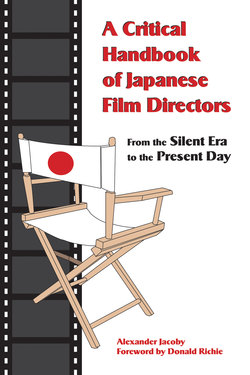Читать книгу A Critical Handbook of Japanese Film Directors - Alexander Jacoby - Страница 17
FUTAGAWA Buntarō
Оглавление(June 18, 1899–March 28, 1966)
二川文太郎
A specialist in jidai-geki, Futagawa is remembered largely for the silent films he made at Makino Productions in collaboration with popular action hero Tsumasaburō Bandō. Several of these survive: Kageboshi (Edo Kaizokuden: Kagebōshi, 1925) is admired for having introduced a greater psychological depth into a genre hitherto concerned largely with action, while the most famous, Orochi (1925), is considered of importance in establishing the anti-heroic persona of the “nihilist hero” in revolt against society, which would be developed by Daisuke Itō. The film’s melancholy mood was genuinely affecting, though it lacked Itō’s depth of political implication, the hero’s sufferings being the result more of hard luck than of social injustice. Noel Burch has called Futagawa “the epitome of the academic neo-Western director”; however, while his style had a certain classical economy, his preference for staging action scenes in long shot was as characteristically Japanese as were his thematic concerns. It seems, moreover, that he made occasional films in a deliberately experimental mode: the lost When the Gravestone Snores (Boseki ga ibikisuru koro, 1925) was apparently influenced by the then fashionable expressionism of The Cabinet of Dr. Caligari (1920, Robert Wiene).
In the thirties, Futagawa worked at Shochiku, where he continued to specialize in period films, often starring the dashing Chōjūrō Hayashi (later renamed Kazuo Hasegawa). However, his sound films were not widely admired, and he retired from direction in 1939. An attempted comeback in the fifties was unsuccessful. Futagawa’s younger brother, Eisuke Takizawa, also worked as a director.
1923 Shinkirō / Mirage
1924 Kaiketsu taka / The Mighty Hawk
Buaku no men / The Devil’s Mask
Kekkon subekarazu / Don’t Get Married
Gekkyūbi no yoru no dekigoto (Kyūryōbi no yoru) / Incidents on the Night After Payday (Payday Night)
Shisen ni tateba / Standing Between Life and Death
Jōnetsu no hi / Fires of Passion
Bonnō jigoku / Hell of Desire
Maen no kiyuru koro / When the Devil-Fire Is Quenched
Koi no ryōnin / Love Hunter
Natsuyoimachi shinjū / Double Suicide at Natsuyoimachi
Kunisada Chūji Shinshū miyako ochi / Chuji Kunisada Leaves the Capital for Shinshu
Gyakuryū / Retaliation
1925 Kunisada Chūji / Chuji Kunisada
Edo kaizokuden: Kagebōshi / Kageboshi (lit. Legend of the Phantom Thief in Edo: The Shadow)
Boseki ga ibikisuru koro / When the Gravestone Snores
Aru tonosama no hanashi / A Certain Lord’s Story
Rantō / Swordfight
Zoku rantō / Swordfight 2
Orochi / Orochi / The Serpent
1926 Enpō kibun: Bijōfu / Strange Story of the Enpo Period: A Handsome Young Man
Shura hakkō (Daiippen; Dainihen; Dansanpen) / The Pains of Hell (Parts 1, 2, and 3)
Guren no chimata: Buke katagi / Neighborhood of Foolish Love: Nature of a Samurai Household
Dondorobori / Muddy Moat
Teru hi kumoru hi (Daiippen; Dainihen) / Bright Day, Cloudy Day (Parts 1 and 2)
Kagebōshi torimonochō: Zenpen / Casebooks of the Shadow: Part 1
1927 Kagebōshi torimonochō: Kōhen / Casebooks of the Shadow: Part 2
Akuma no hoshi no moto ni / Under the Devil’s Stars
Miyokichi goroshi / The Killing of Miyokichi
1928 Dokuhebi / Poisonous Snake
Madara hebi / Spotted Snake
Shinpan Ōoka seidan (Zenpen; Chūhen) / Ooka’s Trial: New Version (Parts 1 and 2)
Hi no warai / Red Smile
Kotsuniku / Flesh and Bone
1929 Taika shinsei / New Dispensation of the Taika Era (co-director)
Isetsu: Shimizu Ikkaku / Heterodoxy: Ikkaku Shimizu
Hatamoto Kobushinshū / Carpenter Retainers of the Shogun
Kunisada Chūji no iji / The Son of the Late Chuji Kunisada
Katana o nuite / Drawing the Sword
Araki Mataemon / Mataemon Araki
Aisuru mono no michi / Way of a Lover
Zoku kagebōshi: Kyōsō hen / Kageboshi 2: Thirst-Crazed Chapter
1930 Donfuku dairensen / Fortunate Great Love
Mōmoku no otōto / Blind Younger Brother
Kaidan Kasanegafuchi / The Ghost of Kasane Swamp
Harenchi gaidō / Shameless Heresy
1931 Kagoya dainagon / Palanquin Bearer and Minister
Ryakudatsu yomego / Abduction of the Bride
Nagebushi Yanosuke: Michinoku no maki / Bawdy Song of Yanosuke: Michinoku Reel
Nagebushi Yanosuke: Edo no maki / Bawdy Song of Yanosuke: Edo Reel
1932 Yajikita: Bijin sōdōki / Yaji and Kita: Trouble About a Beauty
Nawanuke Jihei: Shiranami zaifu / Jihei Nawanuke: The Wallet of Shiranami
Kurama Tengu: Taifū no maki / Kurama Tengu: Typhoon Reel
Kamiyui Shinzō / Shinzo the Hairdresser
Tenbare Hisaroku / Hisaroku under Clear Skies
Adauchi kyōdai kagami / Model Avenging Brothers
1933 Kōsetsu: Nuretsubame / Rumor: Wet Swallow
Yatō to seishun / The Night Thief and Youth
Matagorō kyōdai / The Brothers Matagoro
Unka no kyōteki / Rivals in Cloud and Mist
Tenmei hatamotogasa: Kōrui no maki / A Retainer’s Helmet of the Tenmei Era: A Beautiful Woman’s Tears
1934 Tenmei hatamotogasa: Hareru hi no maki / A Retainer’s Helmet of the Tenmei Era: Brightening Days
Yarisabi renbo / Love of a Rusted Spear
Rinzō shusse tabi / Rinzo’s Journey to Success
Tsujigiri zange / Penitence for the Killing at the Crossroads
1935 Jingi wa kagayaku / Glory of Honor
Umon torimonochō: Hanayome jigoku hen / The Casebooks of Detective Umon: A Bride’s Hell
1936 Iseya koban / Iseya’s Gold
1937 Ruten: Daiichibu: Honoo / Vicissitudes of Life: Part 1: The Flame
Ruten: Dainibu: Hoshi / Vicissitudes of Life: Part 2: The Star
1938 Shunpū Ise monogatari / Tale of the Spring Breeze at Ise
Isetsu: Hatamoto gonin otoko / Heterodoxy: Five Retainers
Nagadosu jiai / Competition of Long Swords
Kimen mikazukitō / Demon-Masked Group of the Crescent Moon
1939 Chūji tabi nikki / Chuji’s Travel Diary
Nijibare kaidō / Road under a Rainbow
1955 Fukushū Jōrurizaka: Onibuse tōge no shūgeki / Revenge at Jorurizaka: Attack at Onibuse Pass
Fukushū Jōrurizaka: Akatsuki no kessen / Revenge of Jorurizaka: Bloody Battle at Dawn
